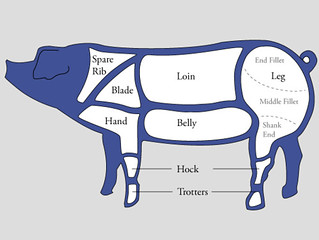Pork knuckles, also referred to as ham hocks or ham shanks, are a coveted cut of meat from the leg of a pig. When simmered low and slow, pork knuckles deliver rich, flavorful collagen that transforms soups, beans, and greens. But if you’ve never broken down a whole hog yourself, you may wonder – where exactly on the pig does this cut come from?
In this article we’ll visualize the pork knuckle’s location, learn how butchers harvest it and explain the anatomical features that make it such a valuable contribution to various dishes. Read on to get a clear, snout-to-tail understanding of where this succulent cut originates.
Anatomy of a Pig’s Hind Leg
Let’s start by reviewing basic pig anatomy. Picture the hind leg of a hog hanging whole prior to butchering. This leg section consists of the thigh, knee joint, shank, and finally the hoofed foot.
The thigh contains large muscle groups like the ham. Below that lies the knee joint, which corresponds to our own knee. The knee flexes the shank, which is the next section containing bone and smaller muscles. Finally at the end of the shank sits the trotter, or foot.
Now zoom in right above the trotter, on the lower shank between knee and foot. This narrower section is the origin of the pork knuckle. It contains a portion of leg bone attached to skin, fat, and some lean meat.
The Pork Knuckle Defined
Specifically the pork knuckle derives from the tibia/fibula bone of the pig’s lower hind leg. This is the bone that runs between the knee and the foot bones. The knuckle cut includes a section of this tibia/fibula bone along with attached skin, fat, and some meat.
Pork knuckles are cut at the joint where the main leg bone connects to the foot bones This leaves a cut consisting of 3-5 inches of the tibia/fibula bone and surrounding tissue When severed at the joint, the trotter or foot comes off, and the knuckle remains attached to the rest of the leg.
How Butchers Harvest Pork Knuckles
When it comes time for butchering, pork knuckles are removed with a few quick cuts. After removing the trotter at the joint, the butcher will run their knife around the remaining shank bone to free up the pork knuckle.
The skin and fat layer are left intact, minimized only by trimming away any hanging flaps or large excess fat. Leaving this covering layer maximizes the collagen content that will melt out during extended cooking times.
Once freed from the rest of the leg, pork knuckles may be sold whole or sliced crosswise into rounds. Whole knuckles are best for extended boiling or braising. Sliced rounds allow seasoning to better penetrate and are ideal for roasting or smoking.
The pork knuckle is one of the quicker cuts to harvest from the hog leg. It requires minimal time and skill in comparison to removing more complex muscle groups. But as we’ll explore next, this humble cut offers huge flavor rewards.
What Makes the Pork Knuckle Special
Given its small amount of lean meat, you may wonder why the pork knuckle is so highly coveted. Here are a few reasons this cut stands out:
-
Collagen-rich: All that connective skin, fat, and cartilage melts down into luscious, body-building collagen.
-
Big meaty flavors: The bone and fat contribute tons of savory pork essence.
-
Versatile: Shines in dishes from soups to stews to beans.
-
Economical: As a rough, working cut, pork knuckles cost far less than premium cuts.
-
Slow cooking: Extended braising or boiling coaxes out the most flavor and tenderizes the meat.
So while the pork knuckle may look humble compared to loin or ribs, its high collagen content and intense porkiness make it a star ingredient. Cooked patiently, it transforms the entire dish.
Try This Flavorful Cut for Yourself
Now that you know exactly where pork knuckles come from and what makes them special, it’s time to try them! Look for whole or sliced pork knuckles at your local butcher or grocery store. Let them work their flavorful magic in your next pot of greens, soup, or baked beans.
With this cut demystified, you can seek out pork knuckles for your cooking with confidence. No longer will you puzzled over where they come from on the pig. Simply look for that joint right above the trotter to locate these gems. Dig into delicious pork knuckle dishes and savor all the lip-smacking, protein-packed collagen they bring to the table!

Your favourite animals and all their tasty parts
Pork Knuckle typically refers to a Pork Hock that has not been cured or smoked. But the meanings can sometimes be the same. For example, Pork Knuckle is thought to be another name for Hock, whether it’s smoked or not. This vegetable can be roasted, boiled, or added to hearty stews to give them their own unique flavor.
The pork knuckle recipe that has gathered millions of views on Youtube!
FAQ
What is the difference between pork knuckles and pork hocks?
What is a pork knuckle?
Where is the pork hock on a pig?
Is there much meat on pork knuckle?
